- Share
- Like
- Tweet
- Digg
- Tumblr
- VKontakte
- Love This
- Odnoklassniki
- Meneame
- Blogger
- Amazon
- Yahoo Mail
- Gmail
- AOL
- Newsvine
- HackerNews
- Evernote
- MySpace
- Mail.ru
- Viadeo
- Line
- Comments
- SMS
- Viber
- Telegram
- Subscribe
- Skype
- Facebook Messenger
- Kakao
- LiveJournal
- Yammer
- Edgar
- Fintel
- Instapaper
- Copy Link
Miralles Tagliabue EMBT has designed a dome for COPAGRI as part of the Expo Milano 2015. The dome will be located in the south-east part of the Lake Arena, one of the main aces of the Expo Milano masterplan, and adjacent to the European Union Pavilion and the Vanke Pavilion.
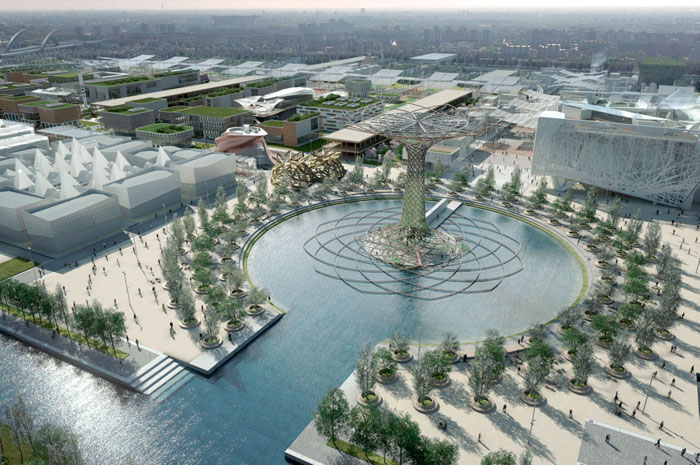
Image Courtesy of © Miralles Tagliabue EMBT
COPAGRI is a confederation of agricultural producers that brings together hundreds of Italian farmers. During the Expo, they will showcase their approach to the use of natural food products, all linked to the Italian tradition, through a market, a hall for cooking demonstrations and two spaces for pizza and ice cream tasting, made with 100% organic products.
More from the architects:
The design started from the observation of Italian landscapes, both natural and man-shaped. During this initial design phase, we had the following thoughts:
The splendor of the Italian cities, which are beautifully represented by their domes. The “landscape” of Rome, Florence, Turin, Venice and Milan is identified with the skyline of their domes, which in different ages always represented the exceptional architectural spaces in Italy. The Pantheon of ancient Rome, Brunelleschi in Florence, Bramante, Bernini, Borromini, Mengoni, Nervi: the Italian domes could tell the story of Italian civilization, and its artistic wonders.
In our project the domes are not only representing the magnificence of the Italian past, but they also show us potential for the future lying in the construction of domes.
Continuing the path illustrated by the engineer and inventor Buckminster Fuller, we propose and experiment domes as sustainable structures that, besides being beautiful, use a minimum of materials so that they can be optimized and designed for production in series with a consequent great ease of construction. The dome, made of wood, represents a message of sustainability and will host several exhibitions, accompanying the visitors in the topics proposed by Expo Milano 2015.
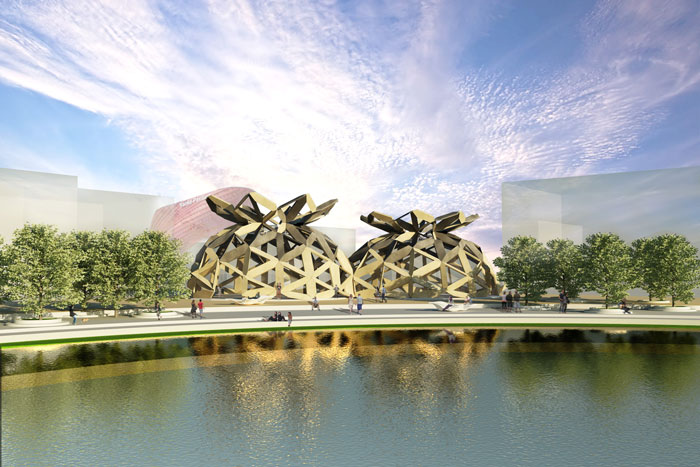
Image Courtesy of © Miralles Tagliabue EMBT
At the end of the Expo, when all the buildings will be removed, these domes can be easily dismantled, transported and reassembled in symbolic Italian places to host a variety of functions. Therefore, they will make this part of the Expo even more sustainable, witnessing for a long time to come the universal message of Expo Milano 2015 “Feeding the Planet, Energy for Life”.
The Dome
The project stems from the combination of two single domes of equal diameter, but different heights. The two domes together create a flexible and well-structured space that could be further subdivided in order to fit different needs of the internal spaces. The double dome consists of an “origami” of structural glulam elements, joined by steel plates.
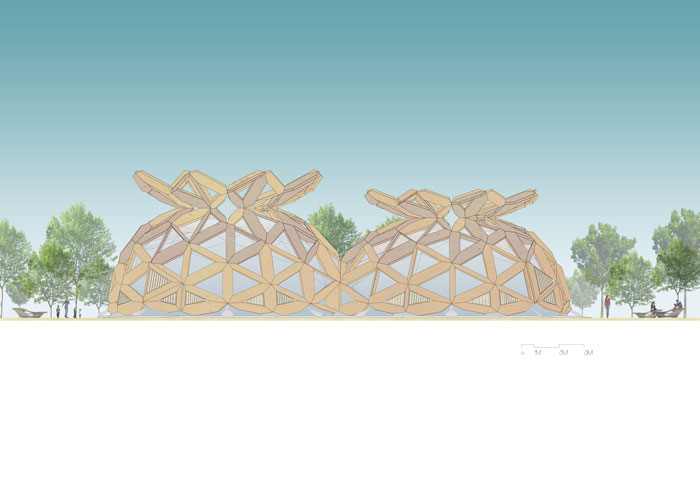
Image Courtesy of © Miralles Tagliabue EMBT
The dome is conceived as a variation of the vast surrounding public space: for this reason, the structures present clear permeability and full congruence with the setting. The open nature of the structure is materialized in a reduced use of mechanical systems, in favour of natural lighting and natural ventilation.
The structure is composed of a big three-dimensional grid that gradually transforms in woven branches, as it grows to the open top of the dome. The structural elements become architectural ones, designing both the internal and the external facades as tree branches; the empty spots of the grid enhance air and light permeability, together with visual continuity between outside and inside.
The double dome is a prefabricated structure, made of spruce glulam with zinc-coated steel joints. Numerical control machines cut the structural elements, and they can be easily assembled and dismantled in agreement with COPAGRI’s need of reuse after the Expo, as expressed by the project competition requirements.
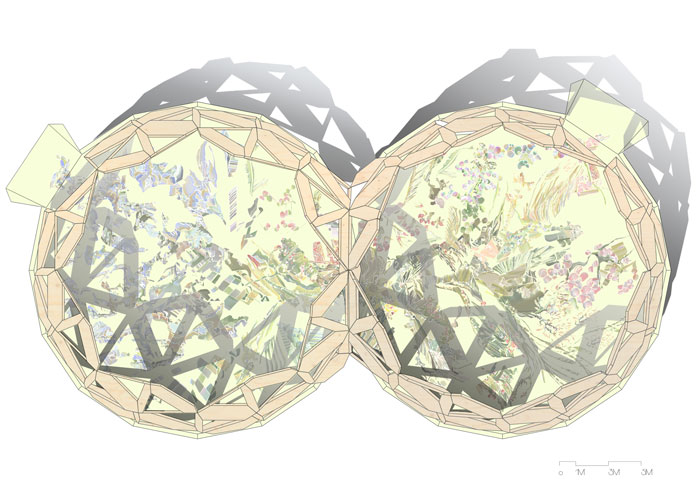
Image Courtesy of © Miralles Tagliabue EMBT
The upper part of the domes, called “the hat”, hosts the required building services both for the building itself and for the Lake Arena, consisting of lights, loudspeakers, antennas … An internal PVC sheet, suspended from the vertexes of the structure, covering the openings and avoiding water penetration, provides water resistance. The PVC seam follows the structural grid.
White translucent pressurized PVC cushions cover the internal space in correspondence of the central oculus: those cushions are not linked to the internal PVC sheet, guaranteeing natural ventilation through stack effect. Natural ventilation is indeed essential: in addition to the upper openings, all the perimeter of the dome is covered with a net fabric, whose zigzag pattern follows the structural grid and ensures ventilation.
The dome appears as a lighting element of the public square: the structure not only includes a self-lighting system, but also provides lighting for the surroundings: it sparkles like a glowing lantern and the light reflects on the Lake Arena water surface, amplifying the splendor of the area. The spectacular translucent lamps, also shaped as a dome, are suspended from the PVC sheet tie-beams and dangle from the structure to light up all the elements of the internal set-up. According to the exhibitors’ needs, the dome has two entrances, in order to optimize the visitors’ flows coming from Palazzo Italia, from the Cardo and from the shows around the Albero della Vita.
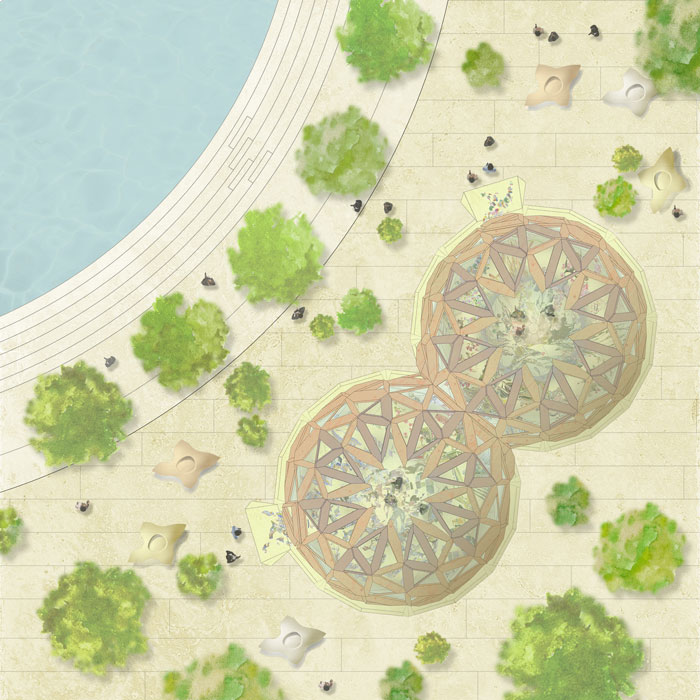
Image Courtesy of © Miralles Tagliabue EMBT
The internal layout is organized in areas. The small dome will host 15 huge triangular counters, recreating the typical Italian market atmosphere. Each counter will host, rotating every week, unique and natural products, narrated by their farmers. Under the bigger dome, a cylinder will house a small cooking demonstration room, a multi-sensorial exhibit and two spaces dedicated to biological pizza and ice-cream tasting.
The entrance doors are made of an aluminum frame and wooden panels: those doors will be opened in the morning and kept open during all day. These modular panels, identical to the structural ones, can be opened and therefore reveal their real nature. In the closing hours of the dome, they will recreate the completeness of the wooden grid. The foundation of the dome is a strip-footing ring made of reinforced concrete. The internal floor is made of high-use-resistant and easy-cleaning, coloured synthetic resin.
Facts:
Location: Lake Arena, Expo Milano 2015. Milan, Italy.
Clients: COPAGRI and Expo 2015 S.p.A.
Design Period: April 2014 – December 2014
Construction Period: March 2015 – April 2015
Architectural Design: Miralles Tagliabue EMBT
Architect: Benedetta Tagliabue
Project Director: Makoto Fukuda
Project Coordinator: Valentina Nicol Noris
Design Team: Dirce Medina, Claudia Baralla, Claudia Manenti, Silvia Pirrera, Gabriele Rotelli, Andres Echevarria, Thomas Hostache, Carlo Cervellieri, Luca Amighetti, Ana De la Cuesta, Ana Zueras, Daniel Combariza.
Technical and scientific support: Matteo Ruta, Emilio Pizzi – Politecnico di Milano, ABC Department, Milano. Collaborators: Alessio Costantino Mirabella, Elena Seghezzi, Ivana Congiu.
Structural Design: Francesco Iorio – SIO Studio Iorio, Bergamo
Fire Engineering: Giuseppe Amaro – GAE Engineering, Torino
Digital Design and Fabrication Consultancy: Pierpaolo Ruttico – INDEXLAB, Milano with Carlo Beltracchi
Built Area: 560 m²
Budget: 600.000 euros
Main Contractor: Foresti Distribuzione Laterizi, Pralboino (BS)
Wood Structure: Foresti Distribuzione Laterizi, Pralboino (BS)
PVC Textile: Canobbio Textile Engineering, Castelnuovo Scrivia (Al)
Lighting: Via Bizzuno
*All images and information courtesy of Miralles Tagliabue EMBT.
